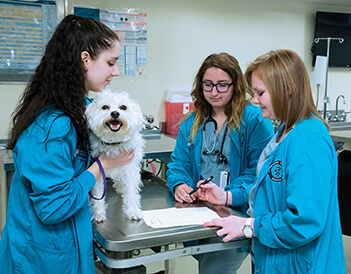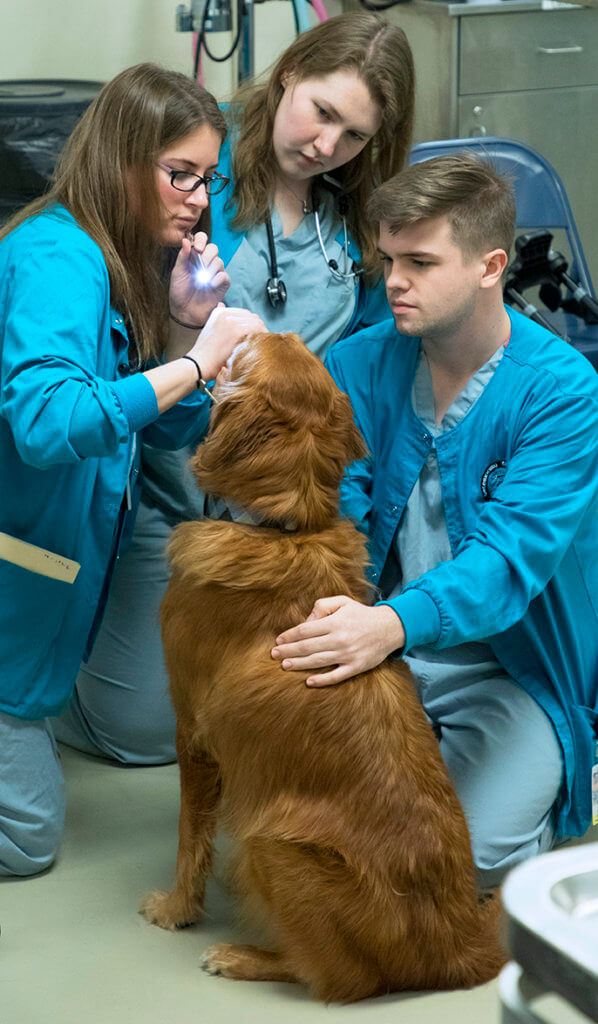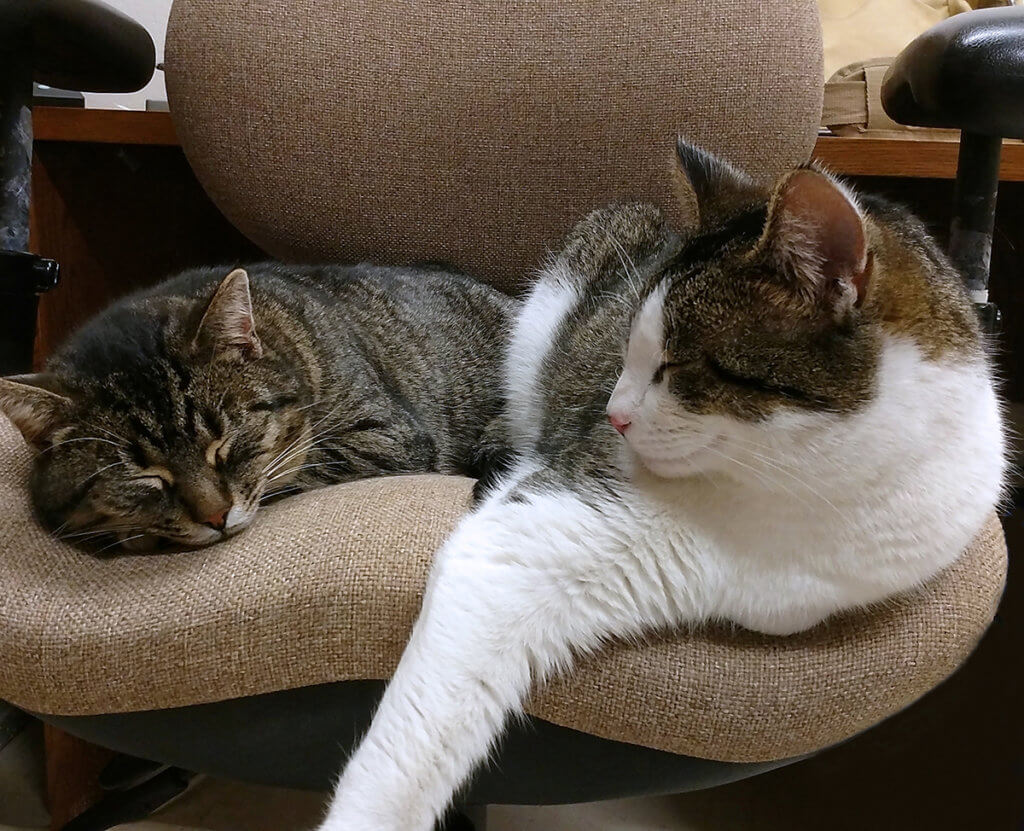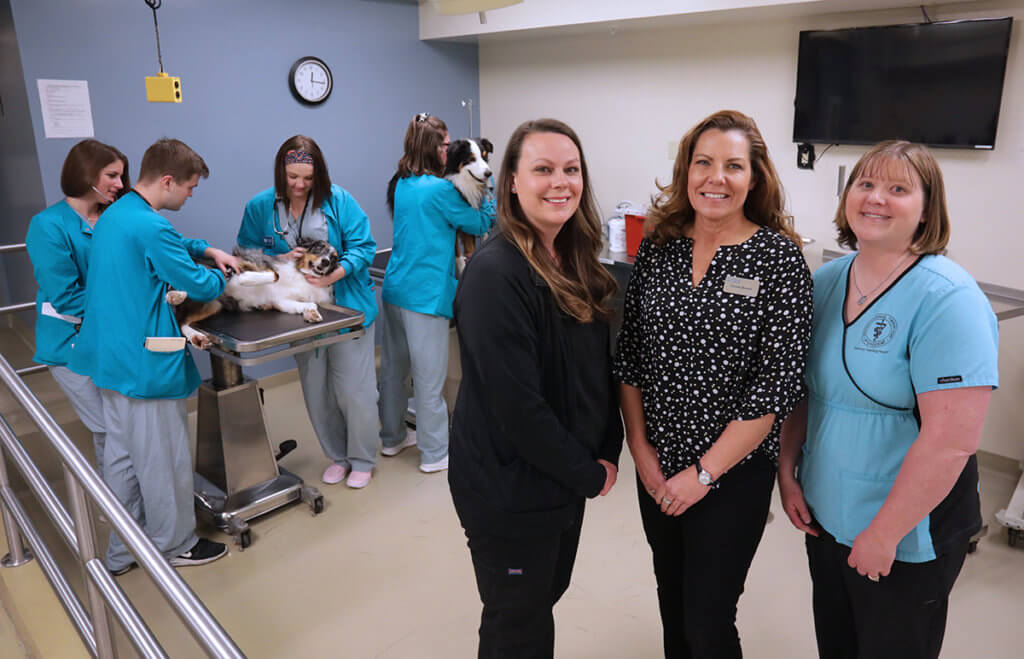
Veterinary nursing students perform a physical exam on Pet Professor Drew.
Pet professors make-up a program within the Purdue University College of Veterinary Medicine (PVM) that allows faculty and staff to volunteer their personal pets to serve as teaching dogs/cats for veterinary nursing and DVM students. Dr. Jim Weisman, assistant dean for student affairs and clinical associate professor, helped set-up the program nine years ago and recently volunteered his own dog, Drew, to become a pet professor. The welfare of the pet is the key focus of the instructional staff at all times when professors are in attendance.
The Pet Professor Program provides a wonderful opportunity for veterinary nursing and DVM students to practice non-invasive techniques for the first time on well-behaved animals while also developing professional relationships with PVM staff and faculty. Students are able to take an annual history, perform a physical exam, and participate in a vaccination lab, all of which prepares them for working in private practice settings. The program is strongly supported by Boehringer Ingelheim, a pharmaceutical company that contributes needed supplies for the benefit of educating veterinary nursing students.

Veterinary nursing students perform an eye exam on a pet professor named Tub.
During the small animal nursing wellness laboratory session, the Veterinary Nursing Program relies on pet professors to help students gain experience with annual wellness exams, immunizations (including rabies, DHLPP, and Bordetella for dogs and rabies and FVRCP for cats), well diagnostics (annual fecal evaluations, heartworm tests, and FeLV/FIV tests for cats only), Home Again microchips, and heartworm and flea preventative. In addition, pet professors also receive Complete Blood Count (CBC) and Small Animal Panel 2 Clinical Chemistry. “I think it is key for our students to see a variety of breeds during their training,” said Dr. Weisman. “This allows them to work with various shapes and sizes of dogs, which truly enables them to develop the necessary skill sets which they will utilize in practice.”
Veterinary Skills and Competencies Manager Jennifer Ashley, who serves as pet professor coordinator, first became involved with the program when she started as an instructor in November 2014. Since then, her yellow Lab, Sydney, has become a pet professor. “Sydney was fearful of car rides prior to her involvement in the program and now she does so much better in the car thanks to her positive experiences coming to work with mom,” said Jennifer. “Some of our pet professors have become better family members by learning new tricks in our behavior labs.”
The Pet Professor Program is a win-win for everyone involved. The dogs and cats benefit from the wonderful socialization with all involved in the program while students have the benefit of a positive interaction with a well-behaved animal that they can practice non-invasive techniques on for the first time.
Cats also serve as pet professors and help “teach” the students about non-invasive procedures such as restraint (cat bag, burrito, muzzles, and cat stretch), practical exams (restraint and physical exam procedures), physical exams, and cardiac exams. Dog “professors” aid the students in learning about a range of non-invasive procedures and techniques, including dermatologic nursing techniques, cardiac nursing, body condition scoring, ophthalmologic nursing, neurologic exams, oral practical exams, behavior, physical therapy, radiographs (thorax, abdomen, and orthopedic), ultrasounds, restraint, grooming, gentle leader fittings, and physical exams.

“Mac” and “Cheese,” pet professors belonging to Paige Allen, assistant director for academic advising and recruiting, rest up after a busy morning educating veterinary students.
In order to accommodate the best teaching environment, the program has the following minimum requirements that each pet must meet to become a pet professor:
- Current on recommended immunizations
- Altered male or female
- Free of chronic disease
- Free of chronic pain
- Well socialized
Dogs must:
- Annually complete the Purdue Good Office Dog certification
- Be heartworm and flea negative
Cats must:
- Annually pass a behavior consult (with PVM Behavior staff)
- Be heartworm, flea, FeLV, and FIV negative
Purdue Veterinary Medicine especially thanks Boehringer Ingelheim for its continued support of this program. The lessons learned in the Pet Professor Program are invaluable and it goes without saying that everyone has come to love all of PVM’s pet professors.

Diagnostic Imaging Instructional Technologist Liane Shaw, Boehringer Ingelheim representative Connie Brewer, and Veterinary Skills and Competencies Manager Jennifer Ashley pose for a photo while veterinary nursing students perform a physical exam on Pet Professors Zoom and Flash.

